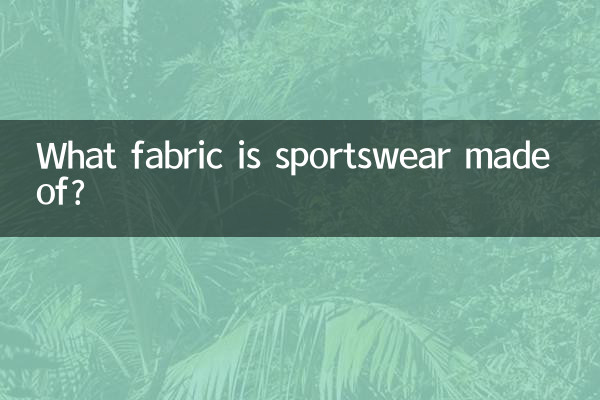What material is sportswear made of? Revealing popular sportswear materials and trends
In recent years, with the popularity of healthy lifestyles, the sportswear market has continued to heat up. Whether it is fitness enthusiasts or daily wear, the fabric selection of sportswear has become the focus of consumers' attention. This article will combine the hot topics on the Internet in the past 10 days to analyze the common fabrics and characteristics of sportswear for you, and attach a structured data comparison to help you make a more informed choice.
1. Common fabric types and characteristics of sportswear

| Fabric name | Features | Applicable scenarios |
|---|---|---|
| Polyester (polyester fiber) | Quick-drying, wear-resistant, wrinkle-resistant, but average breathability | Running, high-intensity training |
| nylon | Good elasticity, light weight and tear resistance | yoga, outdoor sports |
| spandex | Highly elastic and conforms to the body | Tights, swimwear |
| cotton | Good hygroscopicity and comfort, but easy to absorb sweat and become heavy | Daily leisure, low-intensity exercise |
| Blended fabrics (such as polyester + spandex) | Combines multiple advantages such as elasticity + breathability | Comprehensive sports and fitness clothing |
2. Recent popular sportswear fabric trends
According to social media and e-commerce platform data in the past 10 days, the following topics related to sportswear fabrics are relatively popular:
| hot topics | focus of discussion | Heat Index (1-10) |
|---|---|---|
| Environmentally friendly recycled fabrics | Recycled polyester, plant-based materials | 9 |
| Ice technology fabric | Breathable material for cooling in summer | 8 |
| Antibacterial and anti-odor technology | Antibacterial materials such as silver ions and bamboo fiber | 7 |
| Seamless weaving process | Reduce friction and improve comfort | 6 |
3. How to choose sportswear fabrics that suit you?
1.Choose according to sport type: It is recommended to choose polyester or blended fabrics for high-intensity exercises, and spandex or cotton for low-intensity exercises such as yoga.
2.Pay attention to seasonal needs: Choose icy or breathable fabrics in summer, and consider adding velvet warm materials in winter.
3.Pay attention to environmental protection attributes: Recycled fabrics and sustainable processes have become the focus of brand promotion, and environmentally friendly consumers can pay attention to such products.
4.Try-on experience: Elasticity, breathability and fit need to be felt by yourself to avoid relying solely on parameters.
4. Summary
The fabric of sportswear directly affects wearing comfort and sports performance. From traditional cotton to high-tech blends, consumers now have more choices. Combined with recent trends, environmental protection, functionality and comfort are the core directions of future fabric research and development. Hopefully the structured data and advice in this article will help you find the perfect sportswear for you!

check the details

check the details